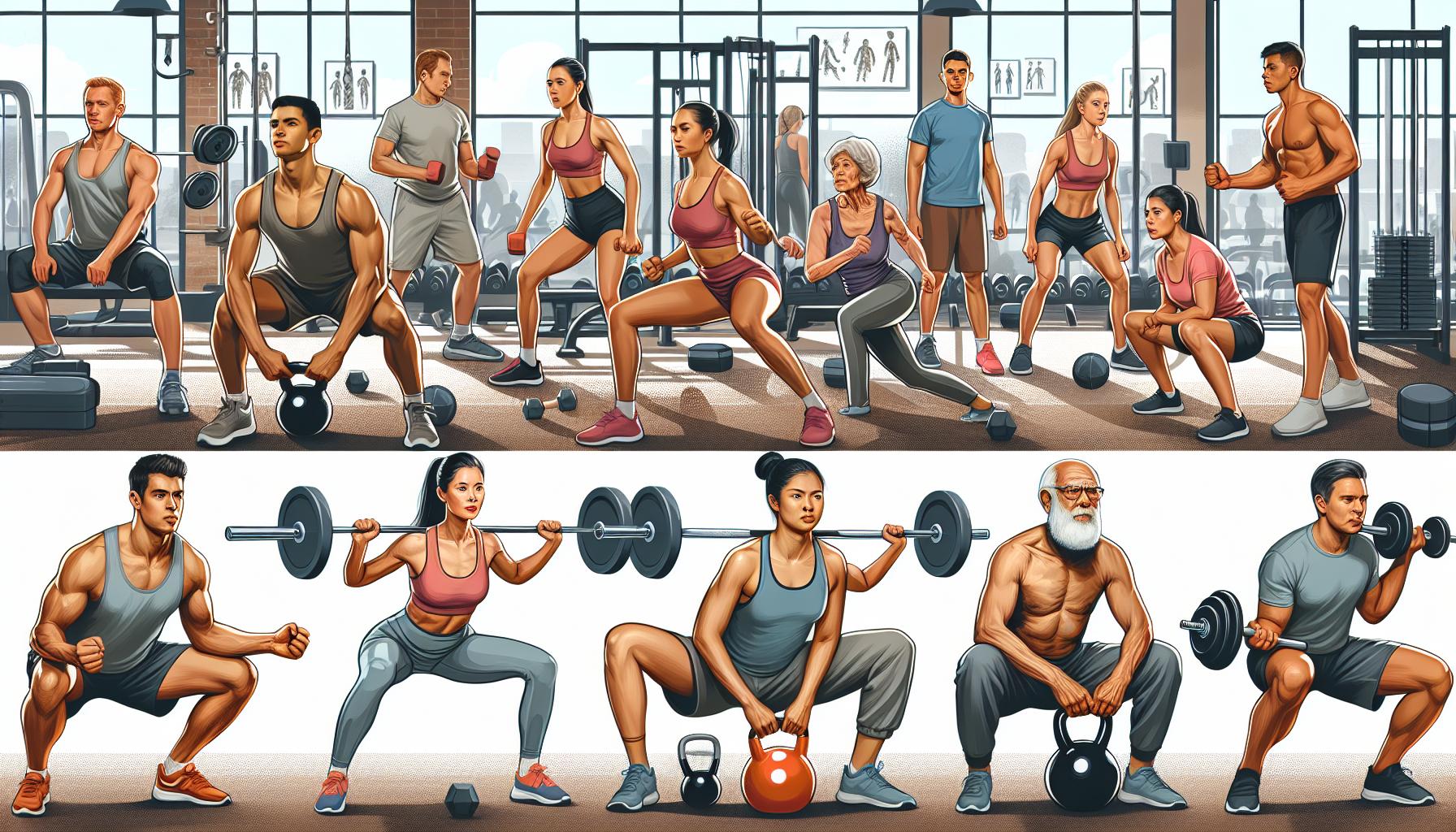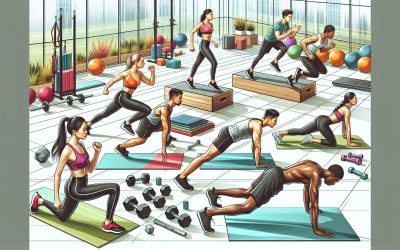Functional fitness enhances everyday movement patterns. Functional fitness is all about preparing your body for real-life activities. It’s the kind of workout that doesn’t just aim for aesthetics but focuses on boosting your ability to perform everyday tasks efficiently. Whether carrying groceries, climbing stairs, or playing with your kids, functional fitness trains your muscles to work together seamlessly.
This approach to exercise mimics everyday movements you might do at home, at work, or in sports. By emphasizing core stability, functional fitness enhances your overall body strength and reduces the risk of injury. It’s not just about lifting weights in a gym; it’s about creating a body capable and resilient in any situation.
Understanding Functional Fitness
Functional fitness is more than just hitting the gym to lift weights or run on a treadmill. It’s a holistic approach to exercise that prepares the body for the rigors of daily life, helping individuals perform everyday activities more efficiently and with less risk of injury. At its core, functional fitness emphasizes exercises that mirror real-life movements, enhancing strength and coordination in ways directly applicable outside the gym.
Functional fitness routines are designed to train muscles to work together harmoniously, focusing on natural movement patterns and body mechanics. This means the exercises engage the entire body instead of isolating specific muscles. Tasks such as squatting, reaching, lifting, or even bracing oneself are practiced to mimic real-world activities. For instance, a functional fitness workout might include squats to simulate picking up something from the ground, emphasizing the correct posture and muscle engagement to prevent back strain.
The benefits of functional fitness extend beyond simple physical strength. One key component of functional training is improving core stability. A strong core is vital for virtually all bodily movements, and enhancing it through functional fitness can significantly reduce the risk of injuries, especially in the lower back area. Furthermore, functional fitness promotes improved balance and flexibility, attributes crucial for efficiently performing daily tasks.
Functional fitness enhances everyday movement patterns: To tailor functional fitness to individual needs, personal trainers often assess a person’s typical movement patterns, including any recurring tasks they perform at work or activities they enjoy doing in their free time. This personalized approach ensures that the workouts are effective and relevant to the individual’s life, making the training sessions more engaging and productive.
Incorporating functional fitness into one’s routine doesn’t require a significant overhaul of existing workouts. Many find success by blending functional training elements with other fitness modalities, such as cardio, yoga, or pilates. This hybrid approach allows for a comprehensive fitness regimen that builds strength, endurance, and flexibility in a balanced manner.
As society moves towards a more integrated understanding of health and wellness, functional fitness is critical in promoting a physically active lifestyle. It challenges the traditional gym routine, offering a refreshing perspective on exercise that prioritizes practicality and real-world application. Whether carrying groceries or chasing after a bus, functional fitness prepares the body to handle daily demands confidently and easily.
Benefits of Functional Fitness Training
Functional fitness training offers many benefits that extend beyond the gym’s walls, penetrating deep into the realms of daily life. At its core, this training method aims to enhance how individuals perform everyday activities, making them more accessible, safer, and more efficient.
One of the primary advantages is the significant reduction in injury risk. Individuals can easily navigate their daily tasks by training the body to move more naturally and efficiently, reducing the strain on muscles and joints. Whether lifting heavy objects or reaching for something on a high shelf, functional fitness prepares the body to handle these actions with less risk of injury.
Improved muscle strength and endurance also stand out as key benefits. Functional fitness targets multiple muscle groups simultaneously through compound movements. This approach builds strength and boosts endurance as the body learns to sustain these efforts. Movements that mimic real-life activities ensure that the strength gained is practical and directly transferable to daily tasks.
Functional fitness enhances everyday movement patterns. Below is a snapshot of the benefits highlighted by recent studies:
| Benefit | Description |
|---|---|
| Reduction in Injury Risk | Prepares the body for daily tasks, reducing the strain on muscles and joints. |
| Improved Muscle Strength | Builds strength through compound movements targeting multiple muscle groups. |
| Increased Endurance | Boosts endurance, allowing the body to sustain effort through prolonged activities. |
| Enhanced Core Stability | Strengthens the core, improving posture and balance for better performance in everyday movements. |
| Better Flexibility and Balance | Increases flexibility and balance, making it easier to navigate physical challenges. |
Moreover, enhanced core stability is a cornerstone of functional fitness. A robust and stable core is vital for virtually every action, from basic movements to complex exercises. This increased core strength translates to improved posture and balance, contributing to a better quality of life.
Lastly, functional fitness promotes better flexibility and balance. Stretching and movements that mimic real-life activities increase flexibility, allowing for a more excellent range of motion. Simultaneously, training the body to perform these movements enhances balance, making falls and related injuries less likely.
Key Principles of Functional Fitness Workouts
Functional fitness enhances everyday movement patterns: Functional fitness workouts are designed to improve daily movement patterns. At the core of these workouts are fundamental principles that ensure each session brings the body closer to natural, fluid movements that mimic real-life activities. Understanding these principles is essential for anyone looking to enhance their quality of life through functional fitness.
Movement Variety is the first principle that guides functional fitness routines. Unlike traditional workouts, which focus on isolating specific muscles, functional training involves a wide range of movements. These include pushing, pulling, squatting, and lifting. This diversity ensures the body is prepared for daily motions, from carrying groceries to lifting a child.
Compound Movements play a critical role in functional fitness. These exercises work multiple muscle groups simultaneously, replicating how the human body naturally moves. For example, a squat strengthens the legs and engages the core, back, and shoulders. By performing compound movements, individuals can improve overall strength and endurance more efficiently.
Another key principle is real-life application. Functional fitness exercises are designed to improve the ability to perform everyday tasks. Whether climbing stairs, bending down to pick something up, or reaching for an item on a high shelf, functional training makes these activities easier and less likely to cause injury.
Progression and Adaptability are essential in keeping the workouts challenging and effective. As individuals become stronger and more adept at the movements, the intensity and complexity of the exercises can be increased. This could mean adding weights, increasing reps, or incorporating stability challenges. Functional fitness’s adaptability ensures that it remains beneficial for people of all fitness levels, from beginners to advanced athletes.
The importance of Core Stability cannot be overstated. The core muscles act as the body’s center of gravity and stabilizer. Strong core muscles are essential for performing specific exercises and improving posture and balance in everyday life. Functional fitness routines often include core strengthening exercises to build this foundation of stability.
Incorporating these principles into workouts can significantly improve how the body performs daily activities. They ensure that the training is comprehensive, targeting the muscles and movements that matter most for quality of life. Individuals can experience a more effective and enjoyable path to achieving their fitness goals by focusing on these critical principles.
Incorporating Functional Fitness Into Your Routine
Incorporating functional fitness into one’s routine doesn’t have to be daunting. It’s all about recognizing what movements and activities one already engages in daily and then building on them. Starting with small, manageable changes is critical for someone new to functional fitness.
One of the first steps is to assess daily movement patterns. Most individuals perform various actions regularly, from lifting groceries to climbing stairs. Identifying these movements can help tailor a functional fitness routine that enhances their execution and efficiency. The following steps outline how to integrate functional fitness into a daily schedule:
- Identify Daily Tasks: Pay attention to everyday tasks that involve lifting, bending, or stretching.
- Incorporate Basic Movements: To strengthen muscles in everyday activities, start with exercises that mimic these tasks, such as squats, lunges, or push-ups.
- Progress Gradually: As one becomes more comfortable with basic movements, it’s crucial to introduce more complex exercises or increase the intensity to continue challenging the body.
Integration of functional fitness can also mean adjusting current workout regimes to include more compound movements. These exercises engage multiple muscle groups simultaneously, such as deadlifts or pull-ups, promoting overall strength and coordination. For instance, adding a set of kettlebell swings can boost power and improve posture and flexibility.
Another practical approach is incorporating equipment that increases the body’s balance and stabilization. Tools like stability balls, resistance bands, and balance boards can simulate real-life challenges, increasing core strength and stability. Here’s a simple way to start:
- Use a Stability Ball: To engage the core muscles throughout the day, try replacing the office chair with a stability ball for a few hours.
- Incorporate Resistance Bands: Add resistance bands to traditional exercises to improve muscle strength and endurance.
The magic of functional fitness lies in its adaptability. Whether one is a beginner or a seasoned athlete, modifications can make each workout appropriate for their fitness level, ensuring they remain challenged but not overwhelmed.
Ensuring a variety of movements is another pillar for successfully blending functional fitness into a routine. This means not just sticking to a specific set of exercises but exploring different physical activities that challenge the body in new ways. Activities such as swimming, cycling, or even dancing can complement a functional fitness regimen, offering enjoyment and the opportunity to improve physical health.
Functional Fitness: A Holistic Approach to Health
Functional fitness transcends traditional exercise norms by focusing on enhancing everyday movement patterns. It’s rooted in the philosophy that fitness should be about more than just aesthetics; it’s about creating a healthier, more efficient lifestyle. This holistic approach revolves around natural and necessary movements for daily activities, promoting overall health and well-being. Individuals can improve their coordination, balance, and posture by training muscles to work together and preparing them for daily tasks.
One key aspect of functional fitness is its inclusivity. Everyone can benefit from incorporating functional movements into their routine regardless of age or fitness level. From young athletes to older adults aiming to maintain independence, functional fitness exercises can be tailored to meet diverse needs. This adaptability makes it a versatile workout option and ensures participants remain engaged and motivated.
The core components of functional fitness include exercises that simulate real-life activities. These might involve multidirectional lunges, which mimic picking up objects from the ground, or overhead presses, which prepare the body to reach for items placed overhead. Such exercises ensure the body remains capable and efficient in performing everyday tasks.
Adding to the holistic approach, functional fitness often incorporates mindfulness and movement patterns requiring mental concentration and physical effort. This combination supports mental health by reducing stress and enhancing cognitive function. It also encourages a deeper connection between mind and body, fostering a sense of self-awareness and control that extends beyond the gym.
Moreover, functional fitness promotes using various tools and environments to challenge the body in unique ways. Stability balls, resistance bands, and body weight enhance balance, strength, and stability. Outdoor settings, too, provide natural and varied terrains that challenge the body, reflecting the unpredictable nature of daily life.
Focusing on movements essential for daily life, functional fitness offers a comprehensive approach to physical and mental health. It emphasizes the importance of preparing the body for real-life challenges through a holistic and inclusive workout routine. Whether improving balance to prevent falls or enhancing strength for better posture, the benefits of adopting a functional fitness regimen are far-reaching.
Conclusion
Embracing functional fitness is more than just a trend—it’s a lifestyle choice that focuses on health, well-being, and the quality of everyday life. It’s a pathway that welcomes everyone, regardless of age or fitness level, to enhance their daily movements and live more comfortably. By integrating exercises that mirror real-life actions, individuals see improvements in their physical capabilities and mental resilience. The beauty of functional fitness lies in its simplicity and profound impact on making day-to-day tasks easier and more enjoyable. So whether you’re lifting groceries, climbing stairs, or simply enjoying a walk in the park, functional fitness ensures you’re doing it all better, safer, and more confident.
Elizabeth Redd: I am a passionate advocate for Health and Healing, dedicated to empowering individuals to live their best lives.
As the founder and publisher of Health and Healing, I have established myself as a guiding force in the wellness industry.
I am committed to providing the latest research, holistic approaches, and inspiring stories to open new possibilities for your health and healing journey.
Learn more about Elizabeth and Join Us at Health and Healing. Also, check out My About Page.





0 Comments